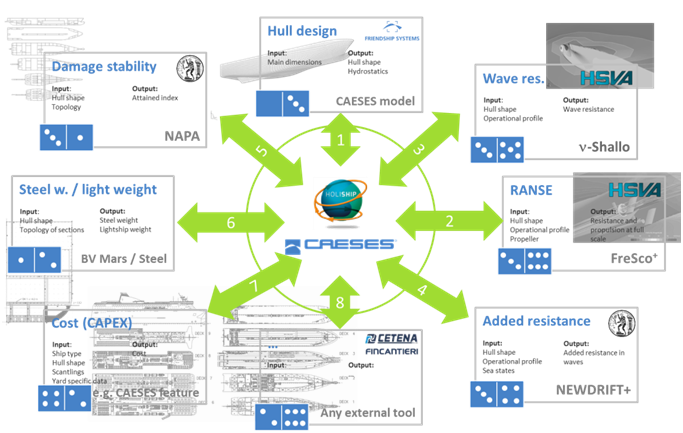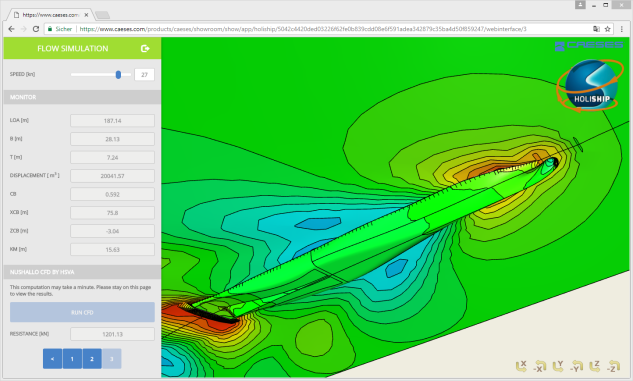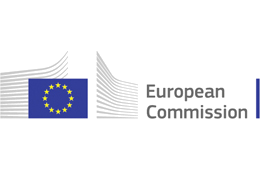HOLISHIP
- Holistic, Life Cycle, Optimisation

Funded with an €11.3 million (US$12.45 million) grant by the Horizon 2020 Transport Research Programme of the European Union, the HOLISHIP project (HOLIstic optimisation of SHIP design and operation for life cycle) 1 is developing the next generation of ship design software systems for the needs of the European maritime industry. This is achieved by adopting a holistic, life-cycle approach to ship design and operation capable of meeting tomorrow’s challenges. The HOLISHIP 4 years project started activities in September 2016 and is now at midterm of developments, while several notable achievements have been already reached and are elaborated in project’s publications (www.holiship.eu).
The design of ships and of maritime assets in general is a complex endeavour requiring the successful coordination of many disciplines, of both technical and non-technical nature, and of individual experts, working at different places, to arrive at valuable design solutions; this applies, also, to the analysis and optimisation of the complex and multi-disciplinary nature of ship’s operation over its entire life-cycle. In this respect, the HOLISHIP project brings together all relevant main disciplines of maritime product design and operation under the umbrella of user-friendly design software platforms, in which advanced simulation and parametric design modelling/simulation tools are integrated. This enables the parametric, multi-objective optimisation of the product ship or of marine assets in general. Market analysis and operational data, hull form, stability, hydrodynamics and structural design, adaptation of prime movers, propulsors and main outfitting, economy, efficiency and environmental considerations form the mission requirements and enable the formulation of a rational foresight analysis for the viability of the product model over its life cycle.
For achieving its goals, HOLISHIP is using modern GUI and information exchange systems allowing the exploration and optimisation of the design space to a much larger extent and lower lead time than in today’s practice. Based on a state-of-the-art process integration and design optimisation environment (PIDO), namely CAESES® by FRIENDSHIP SYSTEMS, HOLISHIP’s design platform integrates first-principles analysis software from various disciplines relevant to ship design and combines them with advanced multi-disciplinary and multi-objective optimisation methods. The HOLISHIP design platform is intended to support ship design through different stages of development, namely from concept through contract design and operational analysis, while dedicated cost models allow for the control of capital and operational expenditures. Compared with traditional approaches the interplay/interaction of all design components/software tools in form of a design synthesis model/integrated software platform allows exploring a much wider design space and, finally, helps generating superior designs (and competitive design alternatives) in substantially less time than in practice today. Figure 1 illustrates this holistic approach to the optimisation of a RoPax. Tools and system data from all disciplines are integrated by design synthesis in the HOLISHIP platform(s), which enables a concurrent analysis and optimisation of systems and components, contrasting the sequential approach associated with the idealised view of the classical design spiral.

Fig. 1. CAESES® CAD Design Software Platform with integrated software tools for the optimisation of RoPax
HOLISHIP aims to develop new insights and promising new design alternatives, while this will be demonstrated through 9 planned Application Case Studies, which are driven by the participating maritime industry. Even more, depending on the degree of fidelity of the employed/integrated geometry models and the software tools, it inherently offers the option of generating virtual prototypes/digital mock-ups of the product. Within HOLISHIP, virtual prototyping is understood as digital mock ups of varying complexity, namely for concept development, design exploration and optimisation, design prototyping and optimisation at the stage of contract design, modelling and optimisation of ship operation, including refined modelling of main systems and components, dynamic modelling and assessment of the ship-prime mover/propulsor-environment interaction (‘Virtual Vessel Demonstrator’ VVD). In HOLISHIP, this will be enabled by the interaction of CAESES® of Friendship Systems and CPACS®, which is supported by DLR (Deutsches Zentrum für Luft und Raumfahrt).
Last but not least: HOLISHIP does not promote a ‘monolithic’ design software system, but rather a flexible software platform in which technical simulation tools (APPs) are being made accessible in different ways, depending on user’s background and the study objectives. In this respect, when using, e.g., CAESES, some APPs can be as simple as generating a hull form for a set of parameters, using a web-browser as a reduced graphical user interface (GUI). Other APPs may be offered as components to be included (as dominos) in larger projects, so-called meta-projects. These components become self-contained CAESES projects which can be addressed from other CAESES projects, making available functionality at a higher-level of abstraction and allowing the streamlining of processes in meta-projects. An example web-based APP (WebApp) is shown in Figure 2. The WebApp computes total resistance at a given speed and a chosen draft for a twin-screw RoPAX with bulbous bow and skeg.

Fig. 2. WebApp for ν-Shallo® of HSVA on the basis of CAESES® of Friendship Systems, see http://www.holiship.eu/approach/

This project has received funding from the European Research Council (ERC) under the European Union’s Horizon 2020 research and innovation programme under grant agreement n° 689074.
- Owner(s) / Author(s)
- HOLISHIP
- Suggestions for further reading
- Publication date
- 18/10/2018
- Funding type
- EU
- Date of entry
- 19/10/2018
- Date of updated
- 19/10/2018
- Start & end
- 01/09/2016 - 31/08/2020